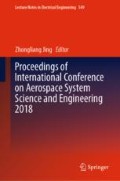Abstract
The flight envelope of aircrafts is hard to expand because the ignition of aviation fuel is unstable at low temperature or low pressure. Investigations on the low-pressure ignition phenomenon, like flame shape, soot formation and so on, have been done a lot. However how to enhance fuel ignition at low pressure is still a puzzle until now. This paper uses the fuel additive to enhance low pressure ignition of hydrocarbon fuel through generating more hydroxyl free radicals (\(\dot{\hbox {O}}\)H) in the fuel combustion. By means of fuel additive design, methoxydiethylborane (MDEB) is selected as a fuel additive in order to promote the low pressure ignition of n-decane. Experimental results show that with the additional 20% MDEB in n-decane, the minimum hot-surface ignition temperature at 1 bar is decreased from 863 to 393 K. The MDEB/n-decane hybrid fuel is able to be ignited at 0.65 bar when temperature is at 443 K. The experimental results are interpreted by the mechanism analysis of additive MDEB in n-decane, which indicates that the oxidization of MDEB produces methoxy free radicals (\({\hbox {C}}{{\hbox {H}}_{{3}}}\dot{\hbox {O}}\)) and ethoxy free radicals (\({\hbox {C}_2}{\hbox {H}_5}\dot{\hbox {O}}\)) to attack n-decane, finally generating more hydroxyl free radicals to enhance fuel ignition. This brand-new method based on increasing hydroxyl free radicals in fuel combustion, is meaningful and practical to enhance low-pressure ignition of hydrocarbon fuel and expand the flight envelope of aircrafts.
Access this chapter
Tax calculation will be finalised at checkout
Purchases are for personal use only
References
Anderson, J.D. (1999). Aircraft Performance and Design, p. 350. Boston: McGraw-Hill.
Fang, J., Tu, R., Guan, J. F., Wang, J. J., & Zhang, Y. M. (2011). Influence of low air pressure on combustion characteristics and flame pulsation frequency of pool fires. Fuel, 90(8):2760–2766.
Dipiazza, J. T. (1951). Limits of flammability of pure hydrocarbon-air mixtures at reduced pressures and room temperature. Technical report, Technical Report Archive and Image Library.
Tao, X., Li, N., & Li, Shaoyuan. (2016). Multiple model predictive control for large envelope flight of hypersonic vehicle systems. Information Sciences, 328, 115–126.
Cho, P., & Law, C. K. (1985). Pressure/temperature ignition limits of fuel droplet vaporizing over a hot plate. International Journal of Heat and Mass Transfer, 28(11), 2174–2176.
Zabetakis, M. G., Furno, A. L., & Jones, G. W. (1954). Minimum spontaneous ignition temperatures of combustibles in air. Industrial & Engineering Chemistry Research, 46(10), 2173–2178.
EI-Wakil, M. M. & Abdou M. I. (1962). The self ignition of fuel drops in heated air streams. SAE Technical Paper: Technical report.
Troe, J. (1977). Theory of thermal unimolecular reactions at low pressures. i. solutions of the master equation. Journal of Chemical Physics, 66(11), 4745–4757.
Schranz, H.W., Nordholm, S., & Andersson, L.L. (1989). Pressure dependence of unimolecular reactions: Collision efficiencies in mixtures of weak and strong colliders. Chemical Physics Letters, 161(4C5), 432–438.
Le, T. M. H. (2015). Flammability Characteristics of Hydrogen and Its Mixtures with Light Hydrocarbons at Atmospheric and Sub-atmospheric Pressures. Ph.D. thesis, Texas A&M University.
Le, H.. Nayak, S., & Mannan, M.S. (2012). Upper flammability limits of hydrogen and light hydrocarbons in air at subatmospheric pressures. Industrial & Engineering Chemistry Research, 51(27), 9396–9402.
Le, H., Liu, Y., & Mannan, M.S. (2013). Lower flammability limits of hydrogen and light hydrocarbons at subatmospheric pressures. Industrial & Engineering Chemistry Research, 52(3), 1372–1378.
Menon, S. K., Boettcher, P. A., Ventura, B., & Blanquart, G. (2016). Hot surface ignition of n-hexane in air. Combustion and Flame, 163, 42–53.
Battin-Leclerc, F., Herbinet, O., Glaude, P. A., Fournet, R., Zhou, Z., Deng, L., et al. (2010). Experimental confirmation of the low-temperature oxidation scheme of alkanes. Angewandte Chemie International Edition, 122(18), 3237–3240.
Li, X., Huang, X., & Liu, H. (2018). A composite-fuel additive design method for n-decane low-temperature ignition enhancement. Combustion and Flame, 188, 262–272.
Bartoszek, M., & Polak, J. (2012). An electron paramagnetic resonance study of antioxidant properties of alcoholic beverages. Food chemistry, 132(4), 2089–2093.
Guo, Q., Qian, S. Y., & Mason, R. P. (2003). Separation and identification of dmpo adducts of oxygen-centered radicals formed from organic hydroperoxides by hplc-esr, esi-ms and ms/ms. Journal of the American Society for Mass Spectrometry, 14(8), 862–871.
Ralph, J., & Hatfield, R. D. (1991). Pyrolysis-gc-ms characterization of forage materials. Journal of Agricultural and Food Chemistry, 39(8), 1426–1437.
Kajiwara, A., Matyjaszewski, K., & Kamachi, M. (1998). Simultaneous epr and kinetic study of styrene atom transfer radical polymerization (atrp). Macromolecules, 31(17), 5695–5701.
Towell, J., & Kalyanaraman, B. (1991). Detection of radical adducts of 5,5-dimethyl-1-pyrroline n-oxide by the combined use of high-performance liquid chromatography with electrochemical detection and electron spin resonance. Analytical Biochemistry, 196(1), 111–119.
Behrendt, F., & Warnatz, J. (1985). The dependence of flame propagation in h2/o2/n2 mixtures on temperature, pressure, and initial composition. International Journal of Hydrogen Energy, 10(11), 749–755.
Acknowledgements
The authors appreciate the funding supports from the Natural Science Foundation of China, under Grant No. 91441205.
Author information
Authors and Affiliations
Corresponding author
Editor information
Editors and Affiliations
Rights and permissions
Copyright information
© 2019 Springer Nature Singapore Pte Ltd.
About this paper
Cite this paper
Shi, Y., Huang, X., Liu, H. (2019). A Method for Enhancing Low-Pressure Ignition of n-Decane Based on Increasing Hydroxyl Free Radicals. In: Jing, Z. (eds) Proceedings of International Conference on Aerospace System Science and Engineering 2018. ICASSE 2018. Lecture Notes in Electrical Engineering, vol 549. Springer, Singapore. https://doi.org/10.1007/978-981-13-6061-9_12
Download citation
DOI: https://doi.org/10.1007/978-981-13-6061-9_12
Published:
Publisher Name: Springer, Singapore
Print ISBN: 978-981-13-6060-2
Online ISBN: 978-981-13-6061-9
eBook Packages: EngineeringEngineering (R0)

